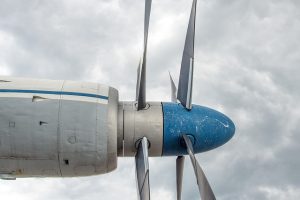
Not all airplanes are powered by jet engines. While most wide-body commercial airlines do, in fact, have jet engines, other airplanes have propellers. Propellers consist of blades that spin during flight. They work by converting the rotary motion of an engine into a slipstream. Even if you’re familiar with the characteristics of propeller airplanes, though, you might be surprised to learn the following facts about them.
#1) The Tip of the Blades Spins Faster Than the Hub
The tip of a propeller’s blades spins faster than the hub. This is why propellers are twisted. As you can see in the photo above, propellers aren’t flat and smooth. Rather, they feature a twisted and curve design. With their twisted design, the angle of attack is reduced from the hub.
#2) Limited By the Speed of Sound
There are several supersonic airplanes. Supersonic, of course, means “faster than the speed of sound.” While some airplanes are capable of traveling at supersonic speeds, none of them are propeller-driven. Propeller airplanes succumb to a loss of efficiency when breaking the sound barrier. Exceeding the speed of sound will create a sonic boom that interferes with the propeller’s ability to convert the rotary motion of an engine into a slipstream.
#3) Increasing the Blade Count Leads to More Thrust
You may discover that some propeller airplanes have more blades than others. Some of them have four blades, whereas others have a half-dozen or more blades. As the number of blades increases, so does the thrust. Propeller airplanes with more blades will produce more thrust than their counterparts with fewer blades. With that said, more blades also increases drag, which makes propeller airplanes less fuel efficient.
#4) Some Airplanes Use Propellers and Jet Engines
There are airplanes that use both propellers and jet engines. Known as turboprop airplanes, they leverage a combustion jet engine that drives a propeller. Turboprop airplanes burn fuel and air in a combustion chamber. The power produced by this combustion process is then used to spin a propeller. When compared to traditional jet airplanes, turboprop airplanes typically fly at lower altitutdes.
#5) Short Takeoffs and Landings
One of the advantages of propeller airplanes is their ability to take off and land on short runwas. They don’t need as much space for takeoffs and landings as jet airplanes. This makes propeller airplanes ideal for smaller airports throughout the world, most of which have short runways.



